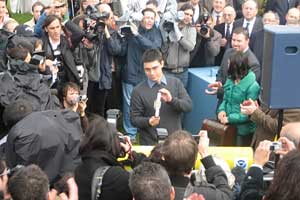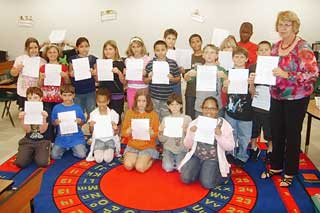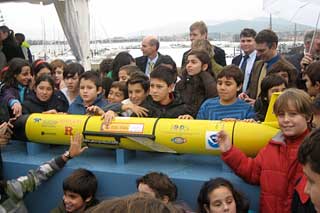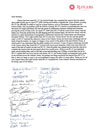Student Letters Across the Atlantic
 In March, 2009, students and classrooms from across the United States
submitted letters to be included inside The Scarlet Knight. These
schools then anxiously followed the progress of the glider to see if
their letters would make it across.
In March, 2009, students and classrooms from across the United States
submitted letters to be included inside The Scarlet Knight. These
schools then anxiously followed the progress of the glider to see if
their letters would make it across.
On the other side of the Atlantic
Ocean, students in Spain were writing their own letters back to the
students and scientists at Rutgers as they watched the glider
approach.
This page documents the participation of these hundreds of
students in the mission.
Letters from the US

During it's mission, The Scarlet Knight carried a thumb drive in its
payload bay that contained 117 letters from 45 classrooms in 10 states.
Because the glider was on a mission of discovery we had no idea where it
would end up or even if it would make it across. In essence, students
were asked to send an old fashioned "message in a bottle," only this
bottle was a high-tech robotic underwater glider.
Here is a small collection of some of the letters students submitted.
Letters from Spain

During the Scarlet Knight's voyage, at least 2 schools and over 50 students in Spain followed the progress of the glider by posting daily updates on their hallway walls and writing letters of their own to Rutgers scientists and students. They also participated in the celebration as the Scarlet Knight reached Baiona.
Here are the letters (both in English and Spanish) that they wrote and the souvenir journal the created and gave to the Rutgers scientists. More letters: 1 2 3
Rutgers Students' Response
 On December 9, 2009, the Scarlet Knight reached Baiona, Spain. There,
Rutgers undergraduate students recovered all the letters from inside
the glider and sent a copy of the original letters back to each
classroom along with a response signed by the students in Rutgers'
Atlantic Crossing class.
On December 9, 2009, the Scarlet Knight reached Baiona, Spain. There,
Rutgers undergraduate students recovered all the letters from inside
the glider and sent a copy of the original letters back to each
classroom along with a response signed by the students in Rutgers'
Atlantic Crossing class.
COSEE
 This collaboration between RU27 scientists and educators and students
was made possible by the Centers for Ocean Science Education
Excellence Networked Ocean World (COSEE NOW). Funded by the National
Science Foundation, COSEE NOW connects scientists and educators in
projects that help promote an ocean literate world using the science and technology available in ocean observing
systems. Check the COSEE NOW website for more
information on future collaborative projects and opportunities to
unite kids, teachers, and scientists in exciting ocean science projects.
This collaboration between RU27 scientists and educators and students
was made possible by the Centers for Ocean Science Education
Excellence Networked Ocean World (COSEE NOW). Funded by the National
Science Foundation, COSEE NOW connects scientists and educators in
projects that help promote an ocean literate world using the science and technology available in ocean observing
systems. Check the COSEE NOW website for more
information on future collaborative projects and opportunities to
unite kids, teachers, and scientists in exciting ocean science projects.
Participating Classrooms






